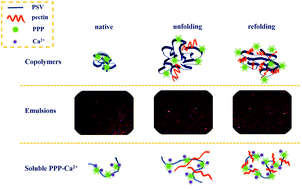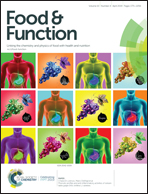Role of polysaccharide conjugation in physicochemical and emulsifying properties of egg phosvitin and the calcium binding capacity of its phosphopeptides
Abstract
Phosvitin phosphopeptides (PPP) effectively enhanced calcium bioavailability via inhibiting calcium–phosphate deposition. It is difficult to hydrolyze native phosvitin (PSV) to release PPP due to its compact structure. Polysaccharide conjugation could improve the biofunctional properties of proteins via altering their structures. In this research, PSV was subjected to conjugation with pectin, and changes in physicochemical characteristics and functionalities were determined. The results showed that PSV underwent an unfolding process when conjugated with pectin at a mass ratio of 1 : 2, exposing more hydrophobic groups. Excessive glycosylation induced a refolded structure with a lower surface hydrophobicity and a higher thermal stability. These secondary and tertiary structural changes improved the emulsifying properties of PSV and allowed the production of emulsions with smaller oil droplets. Simultaneously, due to redistribution of phosphate groups, the PPP derived from copolymers exhibited a stronger calcium binding capacity, especially at a mass ratio of 1 : 6, possessing a potential to be utilized in functional foods.



 Please wait while we load your content...
Please wait while we load your content...